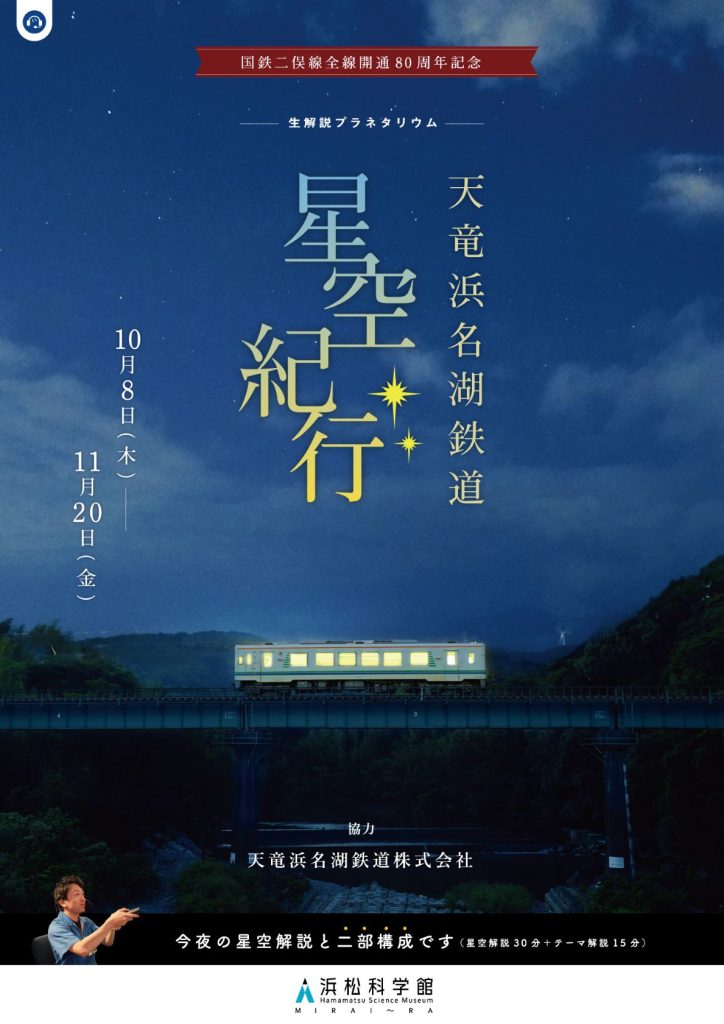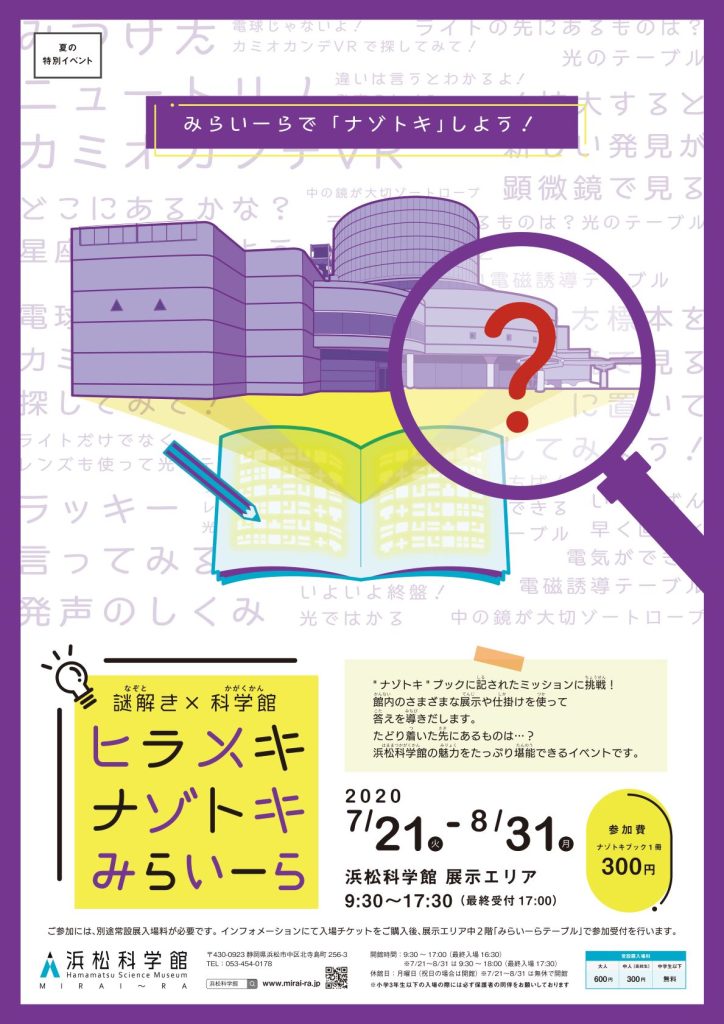
June 17, 2022
Creating an Irreplaceable Value – Hamamatsu Science Museum Amidst the Pandemic
[2022.6.17]
Ryosuke Fujie
Hamamatsu Science Museum
In 2020, COVID-19 infection spread throughout Japan, forcing most museums into temporary closure. The Hamamatsu Science Museum, where I resided at the time, was temporarily closed for about three months, from March to May of the same year. However, there may have been cases of extended closures depending on the circumstances of each museum. Even after the museums were able to reopen, the number of visitors declined when waves of infection rose.
There was a significant impact when the channel for the public to seek value through visiting the museum was narrowed or closed off altogether. Research, collection, and preservation functions in a local science museum such as Hamamatsu Science Museum are limited, and the educational activities are emphasized through exhibitions and events. However, during the pandemic, the facility was faced with a situation that called into question its raison d’être.
Many museums have responded to the pandemic by creating online content. Museums are attempting to create new points of contact by summarizing daily programs in the forms of videos and publishing them online, as a replacement for the channel of visitor flow to the museum.

Hamamatsu Science Museum, also known as Mirai-ra as the official nickname of the museum, released about 80 videos. Each video is approximately 5 minutes and named “Mirai-ra at Home” which aimed to provide hands-on experiments and crafting programs held on location at the museum to the homes of the public. The staff members in charge of these projects, however, felt unease. Information on experiments and handicrafts is abundant on the Internet, and a quick search will lead to many similar videos, furthermore, online viewing is not a substitute for visiting the museum and experiencing them firsthand.
Here, we would like to focus on the most popular videos shown during the temporary closure of the museum for one year, from June 2020 to May 2021. Of the top three viewed videos, the first was how to make soap bubble solution, and the third showed how to make a boomerang out of a milk carton. These two have one thing in common – they are affiliated with the daily science show, a regular program at Hamamatsu Science Museum.
In 2019, the museum completed its renovation, equipped with a stage at its center, where science shows take place. The shows have become a popular feature of the museum, with 20-30% visitor attendance. They feature more than ten performances that change daily, and visitors often ask for instructions on how to make the experimental equipment used in the show, which seems to have led to an increase in the number of views.

My explanation has been somewhat verbose, but what I gathered through this experience is this – we must reexamine what the inherent value of interaction and experiences at the physical facility means for the users, now more than ever, during the pandemic. This confirmed that online videos are not unique by themselves but serve as supplementary information that is an extension of the museum experience.
Rather than focusing on expanding the interface to replace the flow of visitors via the channel, what measures can we implement to enhance the value of the interactions and experiences provided in the actual museum during the pandemic? Let us examine this issue with case studies of other initiatives.
Virtual Trip in a Planetarium “Mirai-ra Night Science Museum”
It is still fresh in our minds that restaurants were asked repeatedly to close or shorten their business hours per measures to prevent the spread of infection, with the state of emergency declaration and quasi-state of emergency. While these measures have devastated the night-time economy, Hamamatsu Science Museum has strived to open at night on the third Friday of every month since July 2020. The museum, which usually closes at 5:00 p.m., has made operating hours temporarily from 5:01 to 7:30 p.m. (6:01 to 8:30 p.m. in August) with special programs for adults, with admission limited to high school students and older.
“STAR FLIGHT,” the planetarium’s special projection, became the backbone of “Mirai-ra Night Science Museum.” In this program, the planetarium staff selects one famous landmark from all around the world each month, projects the local night sky, and explains local myths about the stars. This “virtual trip” unexpectedly met solid demand, attracting more than 200 visitors each month to the museum. Perhaps the increased psychological burden of going out and the drastically reduced opportunities to travel created a particular demand that would not have occurred under normal circumstances. However, this project had been in preparation for more than six months and was not a response to the pandemic. As our staff witnessed adults of different demographics in the evening compared to the daytime, we became aware of the potential value of the facility. Needless to say, the appeal of the special programs was clearly indicated by the demand.


“Tenryu Hamanako Railway Starry Sky Journey” – Making Local Sightseeing Resources into Content
In addition to the aforementioned “STAR FLIGHT,” there is another example of a planetarium projection that created an opportunity for a special experience. The planetarium program “Tenryu Hamanako Railway Starry Sky Journey” was projected at the Hamamatsu Science Museum from October to November 2020.
Micro tourism had gained recognition during the pandemic, and this program embodied that concept through a planetarium. Specifically, the aim is to have visitors of the science museum rediscover the charms of the region, such as the starry sky in the mid-mountain area 30 minutes from the city center, and the scenery along the railway, such as the waterfront, wooded areas, and cultural assets.
To create a sense of realism, the staff in charge of program production boarded an actual train and filmed multiple times with a 360-degree camera in hand. The commentary of the starry skies and the live-action images projected on the dome theater were very well received. It is worth mentioning that the average number of visitors per program was the highest among all the programs projected during the year.


New Tools Expand Enjoyment of Permanent Exhibits: “Aha! Solve the Riddles at Mirai-ra”
One of the challenges museums face in the aftermath of the pandemic is how to redesign services that provide face-to-face contact with visitors, such as exhibition tours. The situation will likely continue for the foreseeable future, where it will be difficult for the staff to approach visitors proactively.
Hamamatsu Science Museum has approximately 100 exhibits and devices, which are conceptually arranged to deepen the visitors’ understanding through the staffs’ interpretation. While it has become difficult to talk to visitors like before, a new tool was developed to enhance the quality of the permanent exhibition areas in an activity book. The booklet “Aha! Solve the Riddles at Mirai-ra” has a “riddle” on each page related to each exhibit. In answering the question, visitors must carefully observe and experiment with the exhibited items.
Approximately 1,500 copies were issued during its operation from July to December 2020. Visitors notably talked to the staff more frequently with the book in hand, and they were interested in exhibits that would usually be overlooked. The second activity book, “Find It, Try It, at Mirai-ra,” is now in operation and establishes itself as a variation of the Hamamatsu Science Museum experience.


In Conclusion
In retrospect, due to our dedication to enhancing the value created through interaction and experience at the museum, we were able to maintain a steady flow of visitors from 2020 to 2021, despite the pandemic. However, as a private company entrusted with the management of public facilities, the status of the business balance cannot be ignored. It is an indisputable fact that there has been an overwhelming decline in user revenue over the past two years, and the business balance would not have been possible without compensation from Hamamatsu City, which established the facility. Assuming that the impact of the pandemic will gradually diminish, the focus will shift to whether the revenue will be restored.
Hamamatsu Science Museum recently formulated a three-year mid-term plan for 2022 to 2024, encompassing the theme “Museum as Cultural Hubs” set forth at the ICOM Kyoto 2019 Conference. All staff are involved in the planning process in our museum, but only a few of them know about the theme of the ICOM Kyoto 2019 conference. Nevertheless, they recognized its importance and began working on it as their mission. Perhaps all of the work we put in during the pandemic has led to a change in awareness of each individual. As a central facility for regional culture development, what value should the museum provide to its users and citizens? This is a question that regional museums should ask themselves, and it was poignantly presented to us during the pandemic, more strenuously than ever.